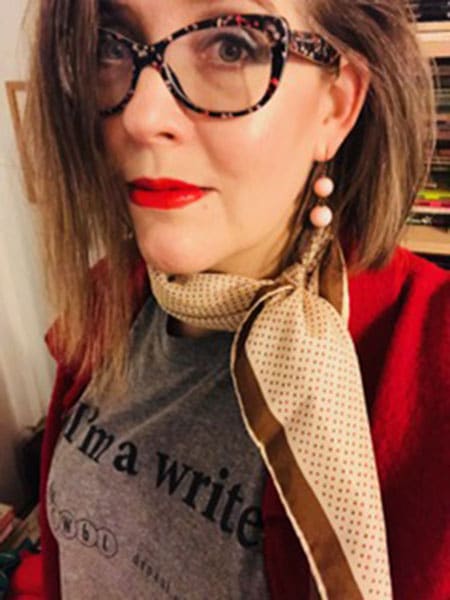This Winter Quarter, Professor Jennifer Finstrom is teaching WRD 371: Mentoring Youth in Community Writing Groups. The course is for students who want to mentor young writers and understand how writing in community functions as an identity-building process. WRD 371 earns Experiential Learning credit in the Liberal Studies Program and is also an elective in the WRD major and Professional Writing Minor. Students provide extensive online feedback for middle school writers engaged in writing projects and also visits to them at their school.
Finstrom spoke with WRD about what it is like to teach this unique course:
“I taught this class for the first time last year, and that was actually the first time that the course was ever taught,” says Finstrom. “Students who take this course can expect to gain experience not only in thinking analytically about what makes effective and affirmative feedback on a piece of writing—in this case, poetry written by sixth graders—but also providing that feedback via a digital platform. Most discussions and readings center on the ideas of community, identity, mentoring, and the benefits of writing groups.”
Finstrom said she would describe the classroom atmosphere as “very collaborative.”
“This class came together as a community early in the quarter, and I’ve really appreciated watching that develop,” she added.
Partnership with Maria Saucedo Scholastic Academy

DePaul University’s WRD program has partnered with Maria Saucedo Scholastic Academy students two years running. Saucedo has students from kindergarten to eighth grade, and Finstrom’s class is working with Alexandra Krueger and Marlena Gustafson’s sixth grade students, the same teachers that they worked with last year.
“The partnership came about through yet another organization, Digital Youth Network (DYN),” explains Finstrom of the DePaul and Saucedo partnership. “It is DYN’s Chicago City of Learning platform that we use to provide feedback to the students. There was an existing partnership between DYN and Saucedo, and last year, WRD was brought into that partnership as well.”
Finstrom says Krueger and Gustafson created a very detailed schedule for a face-to-face visit between DePaul students and 120 Saucedo sixth-graders they work with online. They met in small groups instead of one-on-one.
Developing a Relationship
“One really special thing that happened on this year’s first visit came at the end,” Finstrom says. “Most of my class had to head back to campus or to work, but four students were able to stay longer, and while it hadn’t been a part of the original plan, they visited three different classrooms and held informal Q & A sessions with the Saucedo students about what it’s like being college students—what they like about DePaul and their majors, movies and video games, and much more. I can honestly say that nearly every hand in the room was up and there were no shortage of questions! I think that this was such an important moment in how we’re developing a relationship with our partners and getting to know them. I know that after this visit, my class had such a clear sense of the sixth grade writers as individuals and were able to bring that awareness into their feedback.”
According to Finstrom, the feedback that the DePaul students provide is a combination of affirmation and constructive criticism.
“The poetry challenges start out relatively easy, and with those first ones, we have a good opportunity to build rapport,” explains Finstrom.
The first challenge simply asks the Saucedo students why they write, and this gives the DePaul students the opportunity to say something about themselves as writers and see if their mentees identify as writers or not.
“As the challenges progress, there are more complex prompts, such as ones that ask for an art poem—written from the perspective of an object or person in one of three pre-chosen paintings—and a narrative poem that works with a two-minute memory that the Saucedo students then craft into a poem with a clear beginning, middle, and end.”
Motivations
Each of Finstrom’s students is working with six or seven sixth-grade writers. The DePaul students vary in why they took the class, but many want to teach, have already been teaching, or are student teaching. Other motivations for taking the class have had to do with an interest in writing groups, mentoring, or even because they had younger siblings who were in middle school, according to Finstrom.
“We want the Saucedo students to continue to write and to have confidence in getting their words out there in the world,” Finstrom said. “Last year, the sixth-grade students that we worked with also had a social justice blog that they they shared with us. The mentors and I talk in class about what we were all like in sixth grade and how we were navigating identity at that point and what we would have liked about getting feedback from college students. The act of writing so often causes us to look at who we are and the multiple identities we have more clearly. I feel that in the context of this class, that combines so powerfully with the interaction both in person and online that the Saucedo students and their DePaul mentors have.
*NOTE: This post is written by WRD Student Assistant, Charlene Haparimwi.
